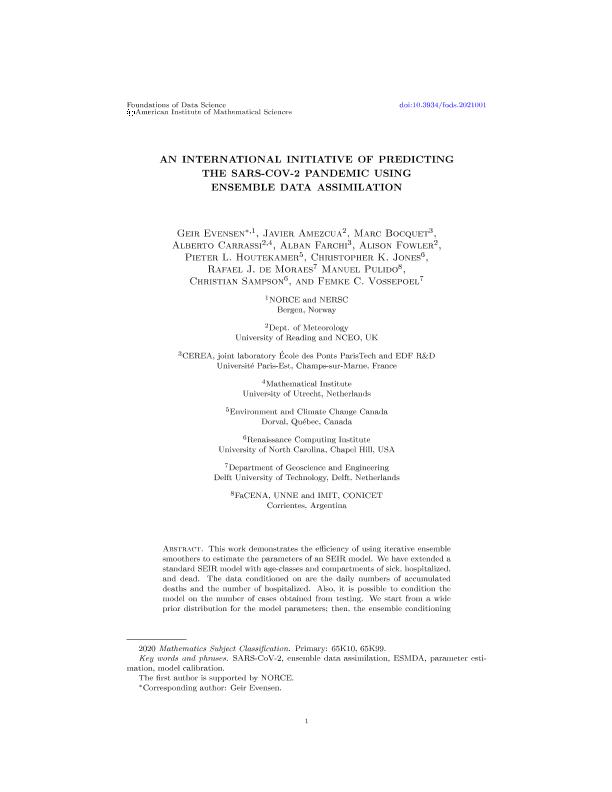Mostrar el registro sencillo del ítem
dc.contributor.author
Evensen, Geir
dc.contributor.author
Amezcua, Javier
dc.contributor.author
Bocquet, Marc
dc.contributor.author
Carrassi, Alberto

dc.contributor.author
Farchi, Alban
dc.contributor.author
Fowler, Alison
dc.contributor.author
Houtekamer, Pieter L.
dc.contributor.author
Jones, Christopher K.
dc.contributor.author
de Morales, Rafael J.
dc.contributor.author
Pulido, Manuel Arturo

dc.contributor.author
Sampson, Christian
dc.contributor.author
Vossepoel, Femke C.
dc.date.available
2021-06-11T16:46:59Z
dc.date.issued
2021-01
dc.identifier.citation
Evensen, Geir; Amezcua, Javier; Bocquet, Marc; Carrassi, Alberto; Farchi, Alban; et al.; An international initiative of predicting the SARS-CoV-2 pandemic using ensemble data assimilation; American Institute of Mathematical Sciences; Foundations of Data Science; 3; 2021; 1-2021; 1-65
dc.identifier.issn
2639-8001
dc.identifier.uri
http://hdl.handle.net/11336/133699
dc.description.abstract
This work demonstrates the efficiency of using iterative ensemble smoothers to estimate the parameters of an SEIR model. We have extended a standard SEIR model with age-classes and compartments of sick, hospitalized, and dead. The data conditioned on are the daily numbers of accumulated deaths and the number of hospitalized. Also, it is possible to condition the model on the number of cases obtained from testing. We start from a wide prior distribution for the model parameters; then, the ensemble conditioning leads to a posterior ensemble of estimated parameters yielding model predictions in close agreement with the observations. The updated ensemble of model simulations has predictive capabilities and include uncertainty estimates. In particular, we estimate the effective reproductive number as a function of time, and we can assess the impact of different intervention measures. By starting from the updated set of model parameters, we can make accurate short-term predictions of the epidemic development assuming knowledge of the future effective reproductive number. Also, the model system allows for the computation of long-term scenarios of the epidemic under different assumptions. We have applied the model system on data sets from several countries, i.e., the four European countries Norway, England, The Netherlands, and France; the province of Quebec in Canada; the South American countries Argentina and Brazil; and the four US states Alabama, North Carolina, California, and New York. These countries and states all have vastly different developments of the epidemic, and we could accurately model the SARS-CoV-2 outbreak in all of them. We realize that more complex models, e.g., with regional compartments, may be desirable, and we suggest that the approach used here should be applicable also for these models.
dc.format
application/pdf
dc.language.iso
eng
dc.publisher
American Institute of Mathematical Sciences
dc.rights
info:eu-repo/semantics/openAccess
dc.rights.uri
https://creativecommons.org/licenses/by-nc-nd/2.5/ar/
dc.subject
SARS-COV-2
dc.subject
ENSEMBLE DATA ASSIMILATION
dc.subject
ESMDA
dc.subject
MODEL CALIBRATION
dc.subject
COVID-19
dc.subject.classification
Enfermedades Infecciosas

dc.subject.classification
Ciencias de la Salud

dc.subject.classification
CIENCIAS MÉDICAS Y DE LA SALUD

dc.title
An international initiative of predicting the SARS-CoV-2 pandemic using ensemble data assimilation
dc.type
info:eu-repo/semantics/article
dc.type
info:ar-repo/semantics/artículo
dc.type
info:eu-repo/semantics/publishedVersion
dc.date.updated
2021-06-10T19:27:38Z
dc.identifier.eissn
2639-8001
dc.journal.volume
3
dc.journal.number
2021
dc.journal.pagination
1-65
dc.journal.pais
Estados Unidos

dc.description.fil
Fil: Evensen, Geir. University of Bergen; Noruega
dc.description.fil
Fil: Amezcua, Javier. University of Reading; Reino Unido
dc.description.fil
Fil: Bocquet, Marc. Universite de Paris; Francia
dc.description.fil
Fil: Carrassi, Alberto. University of Reading; Reino Unido. University of Utrecht; Países Bajos
dc.description.fil
Fil: Farchi, Alban. Universite de Paris; Francia
dc.description.fil
Fil: Fowler, Alison. University of Reading; Reino Unido
dc.description.fil
Fil: Houtekamer, Pieter L.. Environment and Climate Change Canada Dorval; Canadá
dc.description.fil
Fil: Jones, Christopher K.. University of North Carolina; Estados Unidos
dc.description.fil
Fil: de Morales, Rafael J.. Delft University of Technology; Países Bajos
dc.description.fil
Fil: Pulido, Manuel Arturo. Consejo Nacional de Investigaciones Científicas y Técnicas. Centro Científico Tecnológico Conicet - Nordeste. Instituto de Modelado e Innovación Tecnológica. Universidad Nacional del Nordeste. Facultad de Ciencias Exactas Naturales y Agrimensura. Instituto de Modelado e Innovación Tecnológica; Argentina
dc.description.fil
Fil: Sampson, Christian. University of North Carolina; Estados Unidos
dc.description.fil
Fil: Vossepoel, Femke C.. Delft University of Technology; Países Bajos
dc.journal.title
Foundations of Data Science
dc.relation.alternativeid
info:eu-repo/semantics/altIdentifier/url/http://www.aimsciences.org/article/doi/10.3934/fods.2021001
dc.relation.alternativeid
info:eu-repo/semantics/altIdentifier/doi/http://dx.doi.org/10.3934/fods.2021001
Archivos asociados
